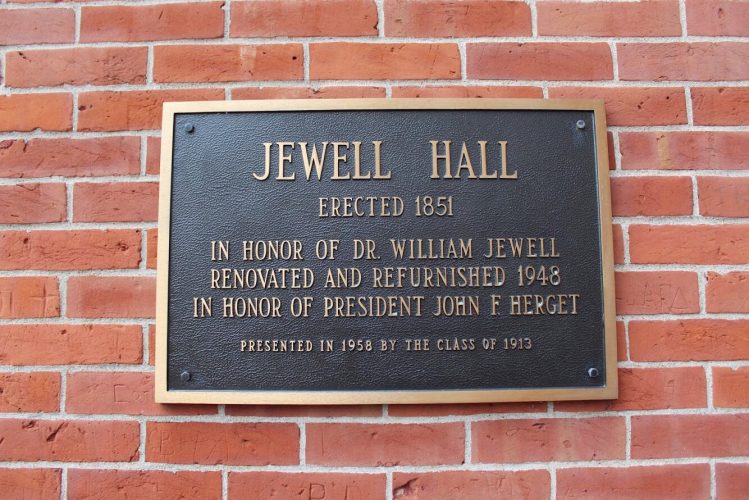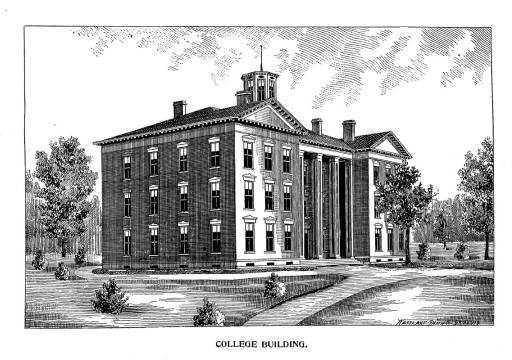William Jewell College (WJC) is the oldest college still in use west of the Mississippi River, and the oldest building at WJC is Jewell Hall. Jewell Hall has a rich history with many legends.
In 1849, the Board of Trustees, including Dr. William Jewell, Alexander W. Doniphan and Rev. Robert James, decided to commence work on a college in Missouri. Fulton and Boonville put in bids, but the winning bid came from Liberty, Mo.
According to an article entitled “Hall Housed Civil War Troops,” it is well-known that the father of Frank and Jesse James, Rev. Robert James, was a donor to the College. Lesser-known is that Robert James pledged $20, roughly $600 in today’s economy, for the construction of Jewell Hall. Unfortunately he died before his debt was paid, bestowing the responsibility of that debt on his next of kin. This means that it was technically Frank and Jesse James who donated the money that funded construction.
There are multiple reports confirming that Dr. Jewell donated the acres of land on which the College sits. However, one report states that it was James T.V. Thompson who donated the land for the campus. It is difficult to say whether or not the report that Thompson donated the land is reliable. Because there are many more reports attributing the donation of land to Jewell rather than Thompson, it is more reasonable to assume that the man for whom WJC was named was the true benefactor.
Dr. Jewell was a Missouri State Senator and Baptist layman. During his career as a state senator, he fought to abolish whipping posts and pillories. While in many aspects Dr. Jewell was a humanitarian and an advocate for freedom, he was a man of contradictions. According to a 1975 article designed to give information to individuals touring WJC, despite Dr. Jewell’s actions against slavery, he was still at one point a slave owner, and slaves made the the bricks used to build Jewell Hall. According to a document about the dedication of the plaque on Jewell Hall honoring former president John F. Herget, Dr. Jewell freed all of his slaves upon his death and ensured they were given the means to begin a new life.
 Construction of Jewell Hall officially began in 1850 and was completed in 1858. Dr. Jewell oversaw construction until his death by sun stroke in 1852. Although he was never professionally trained in architecture or construction, Dr. Jewell had a detailed plan for the College’s focal point. Jewell Hall features Greek-revival style architecture, modeled after a courthouse that Thomas Jefferson designed in Virginia.
Construction of Jewell Hall officially began in 1850 and was completed in 1858. Dr. Jewell oversaw construction until his death by sun stroke in 1852. Although he was never professionally trained in architecture or construction, Dr. Jewell had a detailed plan for the College’s focal point. Jewell Hall features Greek-revival style architecture, modeled after a courthouse that Thomas Jefferson designed in Virginia.
Dr. Jewell was meticulous in managing the project. Legend has it that when he came back from a business trip and saw that the construction crew had already built a 160-foot-long and 3-foot-deep wall without a foundation, he made the crew dismantle the wall, dig until they hit bedrock in order to lay a strong foundation, then rebuild. His attention to detail paid off. The Hall stood for years before its remodeling in 1947.
It was discovered during the remodel that it was almost a miracle it stood so strong for so long. While replacing the flooring and taking down some of the ceiling, repairmen found that Jewell Hall was supported almost entirely by white oak trusses instead of brick. The original builders trusted the wood more than they did the bricks used to build the Hall. Despite this supposed flaw in construction, Jewell Hall stood for almost a century, even surviving the Civil War.
During the war, the Hall was commandeered twice for use by the federal government.
After the Battle of Blue Mills Landing Sept. 17, 1861, Jewell Hall was used as a hospital and barracks for Union soldiers for over five weeks. The Union used it again in the summer of 1862 as quarters and a fort in order to ensure that Confederate troops could not march north of the river.
 The ground floor of Jewell Hall was used as stables, while the second and third floors were used as housing and for hospitalizing troops. For an unknown reason, the soldiers created a 13-inch hole in the wall of the ground floor. Jewell Hall was used as a centralized location for recruitment and the cupola was used as a lookout.
The ground floor of Jewell Hall was used as stables, while the second and third floors were used as housing and for hospitalizing troops. For an unknown reason, the soldiers created a 13-inch hole in the wall of the ground floor. Jewell Hall was used as a centralized location for recruitment and the cupola was used as a lookout.
It is unknown whether Union soldiers were the only troops quartered in Jewell Hall. According to popular thought and most of the articles in the Jewell Archives, WJC was a Union stronghold. However, one article from the Liberty Tribune, dated April 2, 1975, states that both Confederate and Union troops utilized the school grounds. Whether or not Confederate troops used this ground as well is still unclear.
To commemorate Jewell Hall’s use during the Civil War, George Caleb Bingham painted two images of the hall in 1867. Unfortunately, these paintings were destroyed in a fire.
Jewell Hall’s history is punctuated by other significant moments. In 1891, the 1st session of the 51st Congress passed House act 1574. This act recompensed WJC for being used in the Civil War and paid the school $5,200.
In 1920, WJC officially allowed women to enroll as students, marking the first year women were able to achieve higher education at the College and in Jewell Hall.
In 1948, remodeling of the hall was completed and included bathrooms, a new roof, new woodwork, create lecterns and connecting hallways.
Three years after WJC’s 125th anniversary in 1978, Jewell Hall was added to the National Register of Historic Places to commemorate its use in the Civil War and the many years it has stood as a representation of higher education on the western frontier.
Sometime after 1978 a new cupola and shutters were added to Jewell Hall.
Certain materials used in the publication of this work were obtained from the Charles F. Curry Library, William Jewell College, Liberty, Mo.
Photos by Sofia Arthurs-Schoppe.

Hi Savannah,
I wanted to comment on who donated the land for the College. Dr. Jewell donated $10,000 worth of land which he owned in mid-Missouri. He owned no property in Liberty. He was willing to sell that land for the cash or give the land to the trustees as a valued asset.
There’s really no question that the initial eight acres of land where the College sits was given by Judge J.T.V. Thompson. That was well documented during the Sesquicentennial in 1999, which is ehen the last major renovation took place and a cupola put atop the building.
As for Dr. Jewell’s gift, it has long been held that he sold that land and the money from that sale was used for the construction of Jewell Hall.
The College was named for him because it was he who first called for a Baptist college in the late 1830s, but the new state denomination didn’t have the resources to do it then. He renewed his offer of land in 1846 or 47 and Baptists were ready. And the ball got rolling with the official beginning in 1849. He really wanted the school to be in Booneville and withdrew his offer of land, but then reconsidered. Even though Dr. Jewell didn’t get the school where he wanted, Alexander Doniphan suggested the school be named for him.
Jewell history is a fascinating topic. Thanks for writing about it.
David
Thank you for sharing this information! I recently bought a farm in Liberty and moved here from Kansas. I’m very interested in studying the history of this city and now I know a little more =)